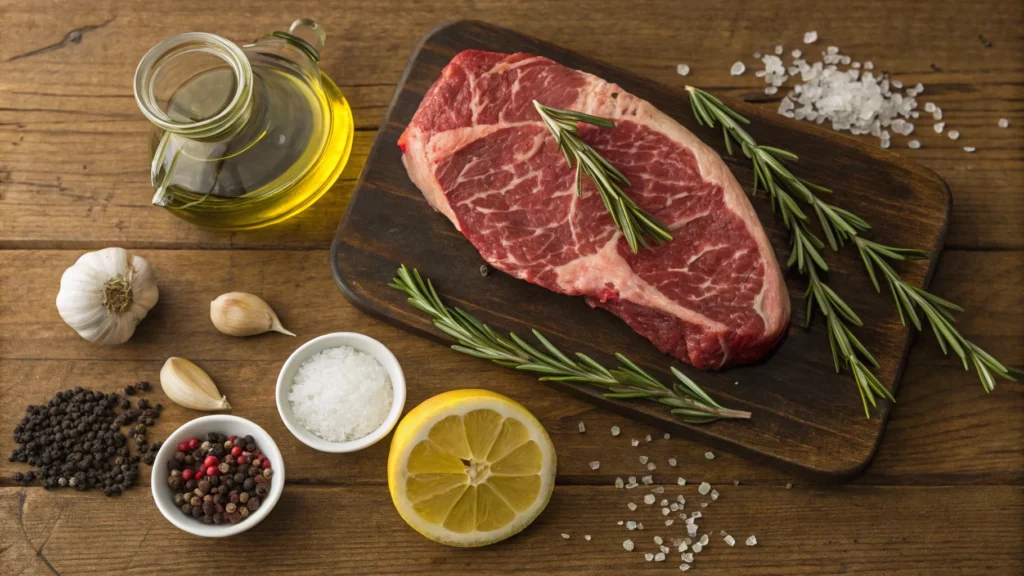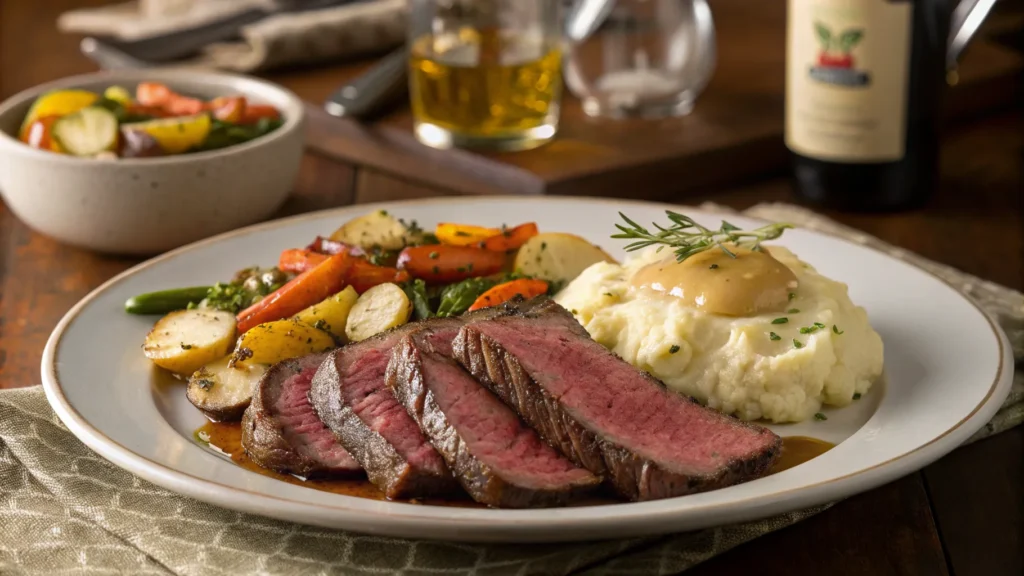How To Make Perfect Beef Shoulder Steak: 5 Essential Tips is your ultimate guide to mastering this flavorful cut. Whether you’re a seasoned home cook or a beginner, these tips will help you turn a tough steak into a tender, mouthwatering meal. From selecting the right cut to cooking it just right, we’ll cover everything you need to know. Let’s dive in!
Table of Contents
Understanding Beef Shoulder Steak
What is Beef Shoulder Steak?
Beef shoulder steak, also known as chuck shoulder steak or ranch steak, comes from the shoulder region of the cow. It’s a versatile, flavorful cut, known for its rich, beefy taste. Though it has a slightly tougher texture compared to premium cuts like ribeye or tenderloin, its lower price and bold flavor make it a favorite among budget-conscious home cooks and foodies alike.
Popular Cuts from the Shoulder
The shoulder area yields various cuts, including flat iron steak, shoulder tender steak, and the classic shoulder roast. Each cut has unique qualities. For example, flat iron steak is ideal for grilling, while shoulder roast works best in slow-cooked recipes. Knowing the differences between these cuts helps you pick the right one for your cooking method.
Why Shoulder Steak is Perfect for Slow Cooking and Grilling
Shoulder steak’s natural toughness melts away with the right preparation, making it perfect for slow cooking or grilling. Low-and-slow methods break down the connective tissue, resulting in tender, melt-in-your-mouth meat. On the other hand, quick grilling over high heat creates a crispy crust while locking in the steak’s juicy interior. No matter your preference, this cut can handle both with ease.
Choosing the Right Cut and Preparation Techniques

How to Select the Best Beef Shoulder Steak
The first step in how to make perfect beef shoulder steak is picking the right cut. Look for steaks with a bright red color, indicating freshness. A good cut should also have a nice balance of marbling—those thin streaks of fat running through the meat. Marbling ensures the steak stays moist and tender during cooking. Avoid pieces with too much connective tissue, as these can turn chewy if not cooked properly.
Essential Tools for Prepping Beef Shoulder Steak
To prep your steak like a pro, you’ll need a few key tools. A sharp knife is essential for trimming excess fat and any silverskin, which can be tough and chewy. A sturdy cutting board keeps your workspace clean and steady. Lastly, invest in a reliable meat tenderizer. While shoulder steak naturally has a bold flavor, tenderizing helps break down the muscle fibers, making it even more succulent when cooked.
Trimming and Pre-Cooking Preparations
Before you start cooking, give your steak some TLC. Trim off excess fat, but leave a thin layer for added flavor during cooking. Let the steak sit at room temperature for 20–30 minutes before cooking—this step ensures even cooking. Don’t skip seasoning! Generously coat both sides with kosher salt and freshly ground pepper, which enhance the steak’s natural flavor.
Marinating for Maximum Flavor
Why Marinating Matters
Marinating is a game-changer when it comes to how to make perfect beef shoulder steak. This step infuses the meat with flavor and helps tenderize it, making each bite a savory delight. A good marinade not only enhances taste but also breaks down the steak’s tougher fibers, ensuring a melt-in-your-mouth texture.
Best Marinades for Beef Shoulder Steak
The best marinades balance acidity, oil, and seasonings. For a classic approach, combine olive oil, balsamic vinegar, garlic, and fresh herbs. Want to spice things up? Try a marinade with soy sauce, ginger, and a splash of sesame oil. Whatever you choose, ensure the steak is fully coated for optimal flavor absorption.
Marination Time Guidelines
Time is crucial when marinating. For beef shoulder steak, aim for at least 2 hours, but overnight is even better. This allows the flavors to penetrate deeply, transforming the steak from ordinary to extraordinary. Be sure to refrigerate the marinating steak and turn it occasionally for even seasoning.

Cooking Methods for Tender, Juicy Steak
Searing for a Perfect Crust
One of the key steps in how to make perfect beef shoulder steak is achieving a beautifully seared crust. Start by heating a cast-iron skillet over medium-high heat until it’s smoking hot. Add a tablespoon of oil, and then carefully place the steak in the pan. Let it cook undisturbed for about 3-4 minutes on each side to create a caramelized crust that seals in the juices. The result? A steak that’s tender on the inside and irresistibly crispy on the outside.
The Benefits of Slow Cooking Beef Shoulder Steak
If you prefer a hands-off approach, slow cooking is your best bet. This method allows the steak to cook gently over a long period, breaking down the tough fibers and delivering fall-apart tenderness. Add your favorite seasonings, a splash of beef broth, and maybe some onions or carrots to a slow cooker. Set it on low for 6–8 hours, and you’ll have a deeply flavorful dish that practically cooks itself.
Grilling Techniques for Shoulder Steak
Grilling adds a smoky depth to beef shoulder steak that’s hard to beat. To keep the steak juicy, use medium-high heat and flip the steak just once. For extra flavor, consider basting with garlic butter during the last few minutes of grilling. Whether you prefer gas or charcoal, grilling will give you a steak that’s bursting with flavor.
Pan-Frying vs. Oven Roasting: Which is Better?
When it comes to pan-frying or oven roasting, each method has its perks. Pan-frying gives you a crispy exterior and a medium-rare center in just minutes. On the other hand, oven roasting is ideal for cooking thicker cuts evenly. For a hybrid method, sear the steak in a hot pan and then finish it in a preheated oven at 400°F for a few minutes until your desired doneness.
Serving and Pairing Suggestions
The Best Way to Serve Beef Shoulder Steak
Presentation matters just as much as flavor when it comes to how to make perfect beef shoulder steak. Let the steak rest for 5–10 minutes after cooking to retain its juices. Slice it thinly against the grain for maximum tenderness. Serve it on a warm plate to keep it hot and fresh.
Side Dishes That Complement the Steak
A hearty steak calls for sides that enhance its rich flavor. Consider serving it with buttery mashed potatoes, roasted vegetables, or a crisp green salad. For a touch of indulgence, pair the steak with creamy mushroom sauce or garlic-infused compound butter.
How to Slice Beef Shoulder Steak Properly
Slicing against the grain is crucial for tenderness. Look for the lines running through the steak and cut perpendicular to them. This shortens the muscle fibers, making each bite softer and easier to chew.

For more hearty comfort food ideas, check out Ultimate Beef Stroganoff with Potatoes.
FAQs: Common Questions About Beef Shoulder Steak
What is the best way to cook beef shoulder steak?
The best way to cook beef shoulder steak depends on the desired outcome, but two popular methods stand out: slow cooking and grilling with a quick sear. For fall-apart tenderness, slow cooking is ideal. Add the steak to a slow cooker with broth, onions, and seasonings, and let it cook on low for 6–8 hours. For a more charred, flavorful crust, sear the steak in a hot skillet or grill it over medium-high heat, cooking each side for about 3–4 minutes. Always rest the steak before slicing to keep it juicy.
What is beef shoulder steak good for?
Beef shoulder steak is a versatile cut, perfect for both hearty main courses and quick weeknight dinners. It’s great for slow-cooked dishes like stews, braises, or pot roasts, where the long cooking time tenderizes the meat and enhances its rich flavor. It also works well for grilling or pan-searing, especially when thinly sliced for tacos, fajitas, or salads. Its bold, beefy taste makes it a great match for marinades and sauces.
How to tenderize shoulder steak?
To tenderize beef shoulder steak, you can use several methods:
- Marinating: Soak the steak in a marinade with acidic ingredients like vinegar, citrus juice, or yogurt to break down tough fibers.
- Meat mallet: Pound the steak gently to physically break up the connective tissues.
- Salt rub: Coat the steak with kosher salt and let it rest for 30 minutes to draw out moisture, which helps soften the meat.
- Slow cooking: Cooking the steak low and slow for several hours will naturally tenderize it.
Is boneless beef shoulder steak tender?
Boneless beef shoulder steak can be tender if prepared correctly. While it’s naturally a tougher cut due to its lean muscle and connective tissue, proper cooking methods—like marinating, slow cooking, or quick searing followed by resting—help achieve tenderness. Slicing the steak against the grain also significantly improves its texture, making it tender and easy to chew.
Final Thoughts and Next Steps
Cooking beef shoulder steak to perfection requires patience, but the results are truly rewarding. With these five essential tips, you’ll transform a humble cut into a mouthwatering meal. Whether you choose to sear, slow cook, or grill, the key lies in preparation, timing, and using complementary flavors. Remember to rest your steak before slicing and serve it alongside well-paired sides for a complete dining experience.
If you’re ready to put these tips to the test, pick up a fresh beef shoulder steak and give these methods a try. The more you cook this flavorful cut, the more confident you’ll become. Want more inspiration? Try experimenting with different marinades and sides to make each meal unique.
For more great recipes, check out The Ultimate Guide to Perfect Ground Beef and Hash Brown Casserole.
Common Mistakes to Avoid (300 Words)
Overcooking the Steak
One of the most common pitfalls when learning how to make perfect beef shoulder steak is overcooking it. Since this cut has a firmer texture, cooking it for too long can make it tough and dry. To avoid this, always use a meat thermometer to monitor the internal temperature. For a juicy medium-rare steak, aim for 135°F, while medium should hit 145°F. Cooking beyond this point will dry out the meat and diminish its rich flavor.
Skipping the Resting Period
Another frequent mistake is slicing the steak too soon. Resting the steak for 5–10 minutes after cooking allows the juices to redistribute throughout the meat, making each bite tender and flavorful. If you cut into the steak right away, those precious juices will run onto the plate, leaving the meat dry.
Not Slicing Against the Grain
The way you slice beef shoulder steak can make or break the dish. Slicing with the grain results in long, tough fibers that are hard to chew. Always slice against the grain to shorten the muscle fibers and create a more tender texture. This simple step makes a world of difference in how the steak feels and tastes.
By following How To Make Perfect Beef Shoulder Steak: 5 Essential Tips, you’ll not only master the cooking process but also create a memorable dining experience. For more cooking inspiration, check out Secrets to a Juicy Pot Roast and Perfectly Fluffy Mashed Potatoes.


1 thought on “How To Make Perfect Beef Shoulder Steak: 5 Essential Tips”